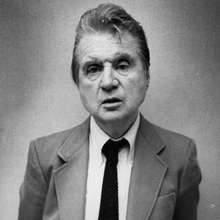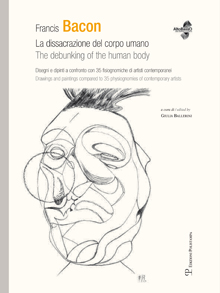Ricerca Veloce
Ricerca Avanzata

Francis Bacon
Francis Bacon nasce a Dublino il 28 ottobre 1909, da genitori inglesi. Compie studi irregolari a causa dei frequenti spostamenti della famiglia, dal 1914, tra Londra e l’Irlanda, dei disagi della guerra e delle sue condizioni di salute, afflitte da una grave forma di asma. Nel 1926 lascia la tenuta di famiglia, dopo un litigio con il padre, avverso alle inclinazioni omosessuali del figlio, e fugge a Londra, poi a Berlino, arrangiandosi nei più svariati lavori: stenografo, segretario, cameriere, cuoco.
Infine, a Parigi, dove avviene la scoperta dell’arte di Picasso, inizia a dipingere i primi acquerelli, con l’intenzione d’intraprendere la strada della pittura. Nel 1929, tornato a Londra, Bacon lavora come designer e arredatore. I primi dipinti sono fortemente influenzati dal Cubismo e dal Surrealismo. In uno studio a Chelsea, dal 1933, nasceranno i primi capolavori, tra cui alcune Crocifissioni. Dopo aver esposto in collettive presso la Mayor Gallery, arriverà un primo riconoscimento dal collezionista Michel Sadler. Nel 1937 presenta le sue opere in una mostra intitolata “Young British Painters”, nella galleria Agnew and Sons di Londra, assieme a Pasmore, deMaistre e Sutherland. In questi anni distruggerà la quasi totalità della sua precedente produzione artistica. Dal 1944, anno che vede la nascita del famoso trittico Three Studies for Figures at the Base of a Crucifixion, Bacon comincerà a dedicarsi esclusivamente alla pittura. La prima personale si tiene nel 1949 alla Hanover Gallery di Londra, organizzata da Erica Brausen, che curerà nei dieci anni successivi la sua produzione artistica.
Nel 1950 Bacon prende parte a numerose mostre, viaggia in Africa e incontra il critico d’arte David Sylvester. Nel 1953 si tiene la sua prima personale all’estero, presso la Durlachers Bros. a New York. Nel 1954 visiterà l’Italia, Ostia e Roma,ma rifiuterà di vedere il Ritratto di papa Innocenzo X di Velázquez, che tanto aveva ossessionato la sua produzione, né si fermerà a Venezia, dove la Biennale ospitava in quel periodo alcune sue opere assieme a quelle di Ben Nicholson e Lucian Freud. Risale al 1956 il viaggio a Tangeri, per raggiungere il compagno Peter Lacy, il qualemorirà nel 1962: Bacon apprenderà la notizia proprio durante l’inaugurazione della sua prima importante retrospettiva, che riuniva alla Tate Gallery di Londra quasi la metà della sua intera produzione, poi spostata a Mannheim, Torino, Zurigo e Amsterdam. Il primo vero successo della sua carriera si era già consacrato nel 1960 con la mostra presso la Marlborough Fine Arts Gallery a Londra.
Un altro lutto accompagnerà anche la sua personale a Parigi, nel 1971, per il suicidio del compagno George Dyer a pochi giorni dall’inaugurazione dellamostra al Grand Palais. Alla sua memoria, Bacon dedica Triptych 1971. Bacon sarà di nuovo nella capitale francese, nel 1977, per la mostra alla Galerie Claude Bernard; l’introduzione al catalogo fu scritta dall’amico Michel Leiris. Nel 1983 si tiene la prima mostra di Bacon in Giappone. Nel 1985-86, la Tate Gallery di Londra gli dedica la seconda grande retrospettiva della sua attività artistica, dal 1944 al 1984. Dopo un ennesimo successo parigino, nel 1987 i media parlano di “Bacon Myth”. Nel 1990-91 l’artista visita l’esposizione di Velázquez al Prado di Madrid; Study from the Human Body avrà come modello l’amico John Edwards, poi suo erede. Nell’aprile 1992, a Madrid, Bacon si ammalerà di polmonite morendo il 28 di quel mese per un attacco cardiaco.
Francis Bacon was born in Dublin on the 28th of October 1909, to English parents. His studies were irregular due to the frequent moving of the family, from 1914, between London and Ireland, to the hardship of war and to his health conditions, afflicted as he was by a serious form of asthma. In 1926 he leaves the family estate after a quarrel with his father, hostile to the homosexual inclinations of his son. He flees to London, then to Berlin, getting by with a variety of jobs: shorthand writer, secretary, waiter, cook. Finally in Paris, where he discovers Picasso’s art and he begins to paint the first watercolours, with the purpose of taking up the painting career. In 1929, back to London, Bacon works as a designer and interior designer. The first paintings are strongly influenced by the Cubism and the Surrealism. In a studio in Chelsea, from 1933, the first masterpieces were born, among which some Crucifixions. After the exhibition in collectives at the Mayor Gallery, a first acknowledgement will come from the collector Michel Sadler. In 1937 he shows his works in an exhibition entitled “Young British Painters” at the Agnew and Sons Gallery in London, with Pasmore, de Maistre and Sutherland. During these years he will destroy almost all of his previous artistic production. From 1944, year in which the famous triptych Three Studies for “Figures at the Base of a Crucifixion” was born, Bacon will begin to devote himself exclusively to painting. The first personal exhibition was held in 1949 at the Hanover Gallery of London, organized by Erica Brausen, who will be curating his artistic production for the following ten years.
In 1950 Bacon takes part in many exhibitions, he travels to Africa and meets the art critic David Sylvester. In 1953 his first personal is held at Durlacher Bros. in New York. In 1954 he will visit Italy, Ostia and Rome but he will refuse to see Velázquez Portrait of Pope Innocenzo X which had influenced his production so much, nor will he stop in Venice where the Biennale was hosting in that period some of his works with those of Ben Nicholson and Lucian Freud. The trip to Tangier dates back to 1956, to reach his partner Peter Lacy who will die in 1962: Bacon will learn the news just during the opening of his first important retrospective, which reunited almost half of his production at the Tate Gallery in London and which then moved to Mannheim, Turin, Zurig and Amsterdam. The first real success of his career had already consecrated him in 1960, with the exhibition at the Marlborough Fine Arts Gallery in London.
Another death will accompany his personal exhibition in Paris too, in 1971. The suicide of his partner George Dyer, a few days before the opening of his exhibition at the Grand Palais. To his memory, Bacon dedicates Triptych 1971. He will be in the French capital again in 1977, for the exhibition at the Galerie Claude Bernard. The introduction to the catalogue was written by his friend Michel Leiris. The first Bacon exhibition in Japan is held in 1983. In 1985-86, the Tate Gallery in London dedicates him the second big retrospective of his artistic activity, from 1944 to 1984. After the umpteenth success in Paris, in 1987 the media talk about the “Bacon Myth”. In 1990-91 the artist visits Velázquez exhibition at the Prado in Madrid; Study from the Human Body will have as a model his friend John Edwards, later to become his heir. On April 1992 Bacon will fall ill with pneumonia in Madrid and will die on the 28th of that month after a heart attack.
Vedi anche...
Francis Bacon
- € 10,80
- € 12,00
